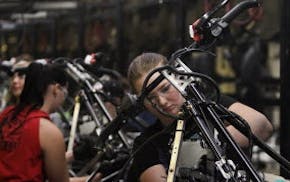Nearly 1 in 8 school buses operated by First Student, Minnesota's largest student transportation company, failed to meet state safety standards this year.
First Student's failure rate of 12% exceeded the statewide average of 9%, according to the latest inspection data from the Minnesota Department of Public Safety. As a result, 141 buses from First Student's fleet of 1,160 were pulled from the road until the repairs were addressed.
In addition to the buses that failed inspection exams, First Student was given 14 days to make repairs on another 143 buses.
Lt. Brian Reu of the State Patrol said that any school bus provider with a report surpassing the state average failure rate raises concerns.
"We're talking about student transportation and student safety, which is very important to us," said Reu, director of pupil transportation for the state's public safety department. "We want to make sure every kid is getting to and from school safely."
Under state law, every school bus — whether district-owned or owned by a private company — must be inspected once a year. Those with chronic problems are selected for random checks or must retake the assessment. Several thousand Minnesota students ride the 1,160 First Student school buses inspected so far in 2019.
First Student buses flunked the test for serious safety defects such as brakes, flat tires, steering, an emergency door buzzer, fuel-leak filter and a missing underbody belt for securing a wheelchair, and for multiple minor infractions such as a defective door gasket, headlamp, loose seats and an exhaust leak in the system, according to data obtained by the Star Tribune.
The state data show that First Student buses operating in Bloomington, Plymouth, Tonka Bay, Champlin, Brooklyn Park, St. Paul and Anoka had failure rates ranging from 12% to 31%. Half of the buses operated by the Plymouth bus company that provides transportation to 7,500 to 8,000 students at Wayzata Public Schools did not get a passing grade, state data show. But school district officials said of the 87 buses used to transport their students, 82 passed inspections and five were taken out of service for repairs.
Chris Kemper, a spokesman for First Student, Inc., a Cincinnati-based company, said their large fleet size has led to more inspections than other large carriers that operate in Minnesota and that ensuring student safety is a high priority.
"We had 400 percent more inspections than the next largest carrier, and more inspections than the next five carriers combined," Kemper said in a statement to the Star Tribune. "With this scale comes increased complexity and intricacy in our operation."
There are no surprises, Reu said. Each school bus is inspected at least once a year and transportation companies typically know the month and dates of their annual inspections, with at least a month's notice given to companies to prepare their buses.
"These are announced inspections, and they know we're coming," he said. "They're still having that many vehicles fail. It's always a safety concern and an issue when a bus fails."
Grading buses
To assess school bus roadworthiness, the State Patrol employs a point value system. Its inspectors scan inside and outside the bus, checking the condition of the frame, body, steering, suspension, exhaust, fuel systems and electrical components. Each school bus must meet all of the equipment and design standards. In addition to its own requirements, Minnesota uses national standards for the design specifications, which are revised every five years.
Each school bus starts with a score of 100, and points are subtracted as defects are found. Major defects such as problems with tires or brakes deduct 25 points from the total score, while minor violations take five points off. School buses that score 96 to 100 pass the inspection, and an annual certificate is attached to their windshields to show their streetworthiness.
A school bus with an inspection score of 80 to 95 points receives a temporary sticker, requiring every defect to be fixed within 14 days.
School buses are not given new inspection reports when violations are addressed, to avoid inflating the initial inspection numbers.
A score of less than 80 is deemed unsafe, and those buses are immediately barred from the road. Those who defy the rules and operate buses with unrepaired defects and without inspection certificates can be cited for a misdemeanor.
Although there's no mandate for bus companies to disclose their inspection information to school districts, detailed annual inspection reports are listed on the State Patrol's website. Some school districts use it to keep tabs on their school buses, said Reu.
"We certainly would encourage every school that's hiring out their service or conducting their own to keep track of [how] their fleets are doing because it comes down to student safety," he said.
But when inspections reveal chronic safety problems, the State Patrol sounds the alarm and meets with school leaders and bus companies. Sibley East Public Schools and transportation company Schmitz Bus Service, Inc., were among those flagged for recurring violations.
Sibley East, a south-central Minnesota district that serves communities in Arlington, Gaylord and Green Isle in Sibley County, has long struggled to meet the state's safety standards. For more than 30 years, the school district has been running its school bus service in-house. But in the last couple of years it became apparent to school leaders that their aging buses had chronic problems. This school year, the district signed a contract with a company called 4.0 School Services to transport its students.
"We're trying to address the safety," district Superintendent Jim Amsden said. "It's challenging, and I'm sure it's challenging for many districts."
Faiza Mahamud • 612-673-4203

After a bumper crop of new sales taxes approved in 2023, legislators eye limits

Minnesota plan to close state addiction treatment facilities faces pushback

Why you should donate clothing: It (probably) won't end up at the dump
4 are now charged in inside job armed robbery of Hopkins grocery store that netted $45K

